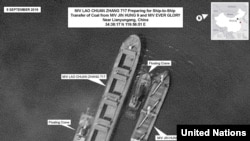On September 5, 2019, large bulk carrier ship Lao Chuan Zhang 717 was spotted near the port of Lianyungang in Jiangsu province in eastern China, about 620 kilometers southeast of Beijing.
Satellite imagery appears to show the vessel preparing to conduct a ship-to-ship transfer with a North Korean vessel, the Jin Hung 9, next to another North Korean vessel, the Ever-Glory.
The Lao Chuan Zhang 717 then proceeded north to Caofeidian port in Hebei province, about 200 kilometers east of Beijing, and offloaded its coal, according to the latest annual report from the U.N. Panel of Experts that monitors compliance with the sanctions on North Korea.
Bulk carriers
The U.N. panel's report points to the use of bulk carriers as a worrying new development.
“The utilization of larger vessels that have a carrying capacity two or three times that of the DPRK [North Korea] vessels suggests that much larger quantities of illicit coal can be transshipped per voyage," the U.N. report noted.
The panel also highlighted North Korea’s illegal ship-to-ship transfers have primarily moved from the South China Sea to the East China Sea, including Lianyungang port, which is closer to North Korea.
The Panel of Experts said the change in location “likely decreases the turnaround time for coal deliveries," “makes deliveries more cost effective” and “likely contributes to reducing its vessels’ exposure to scrutiny.”
Chinese-flagged ships
While many vessels engaging in sanctionable activities generally fly flags of convenience and use front companies, vessels owned by Chinese shipping companies were sighted conducting illegal cargo exchanges with North Korea in recent months.
On September 29, 2019, the Fu Xing 9, owned by a Chinese shipping company, was located near several North Korean vessels near Lianyungang port and was subsequently observed discharging coal at the Caofeidian port.
The Fu Xing 12 was sold by a Chinese state-owned enterprise in June 2019 and recorded on a maritime database as having been broken up, but from August to November that year it was reported to have visited North Korean ports several times under three flags.
“It is quite concerning that the evidence is beginning to show that the Chinese government is either actively supporting U.N.-prohibited activity or at the very least being criminally negligent,” a Security Council member told VOA. “It’s unsettling that a major Chinese state-owned enterprise could be involved in criminal behavior that is supporting the DPRK’s WMD [weapons of mass destruction] and ballistic missile program.”
Increased coal exports
The report said North Korea’s illicit coal exports increased in 2019. According to an unidentified member state, North Korea exported 3.7 million tons of coal between January and August 2019, with an estimated value of $370 million.
In response to North Korea’s pursuit of nuclear and missile programs, the Security Council has adopted a series of sanctions resolutions since 2006. The most biting sanction was adopted in 2017, banning key North Korean exports like coal, seafood and textiles, and significantly reducing the amount of petroleum North Korea is allowed to import.
The U.N. Panel of Experts stressed that North Korea’s illicit maritime exports “provide a revenue stream that has historically contributed to its nuclear and ballistic missile programs.”




